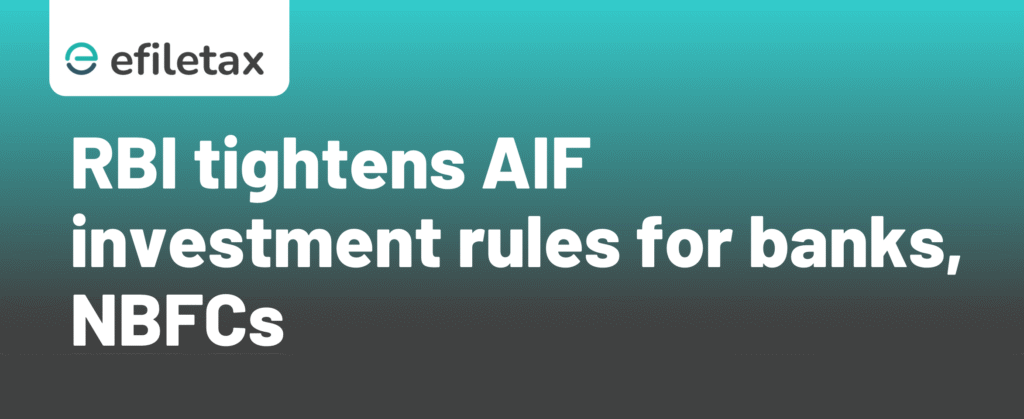
RBI AIF Investment Rules for Banks and NBFCs: What Changed?
The Reserve Bank of India (RBI) has tightened norms on investments in Alternative Investment Funds (AIFs) by regulated entities like banks and NBFCs. The revised AIF investment rules for banks and NBFCs are aimed at curbing evergreening of loans and improving transparency in fund-based exposures.
Let’s decode the new directions and their implications.
Why Did RBI Amend AIF Investment Rules?
As per the RBI circular dated 19 December 2023, it was observed that some regulated entities (REs) were investing in AIFs that subsequently invested in companies that had defaulted to the same REs. This indirect exposure defeated the purpose of provisioning and prudential norms.
To plug this loophole, the RBI has issued new guidelines under the powers conferred by the Banking Regulation Act, 1949, and the RBI Act, 1934.
Key Changes in RBI’s New Directions on AIFs
1. No Downstream Investment in Debtor Firms
If an AIF has invested in a company that has defaulted on any credit facility of the bank or NBFC (the investing RE), then:
- The RE must liquidate its investment in such AIF within 30 days from the date of downstream investment.
- If not liquidated, the RE must make 100% provision on the invested amount.
✅ This applies even if the AIF invested indirectly via subsidiaries or SPVs.
2. Treatment of Existing Investments
- The new rule applies only to investments made after 19 Dec 2023.
- Existing investments are not subject to forced liquidation.
- However, provisioning norms apply if such downstream exposure is identified in post-cut-off investments.
3. Reclassification of AIF Exposure
Banks and NBFCs must now classify AIF exposure under:
- Investment portfolio, and
- Standard asset classification, subject to risk weight norms.
Also, any exposure to AIFs which leads to indirect lending or equity exposure to a debtor entity shall be treated as an exposure to that entity.
RBI Compliance Checklist for AIF Investment
| Requirement | Timeline | Impact |
|---|---|---|
| Identify AIFs investing in debtor companies | Immediate | Risk of 100% provisioning |
| Liquidate such AIF exposure | Within 30 days | Avoid provision requirement |
| Maintain updated investment classification | Ongoing | Regulatory compliance |
| Review agreements with fund managers | Before new deals | Legal and operational changes |
Expert Insight: What Should Banks and NBFCs Do?
“Before investing in any AIF, banks and NBFCs must now mandate complete portfolio transparency from fund managers. Due diligence on downstream investments is no longer optional — it’s compliance-critical.”
— Compliance Head, Mid-size NBFC
Legal Basis for New RBI Norms
These rules are backed by:
- Section 35A of the Banking Regulation Act, 1949
- Section 45L of the RBI Act, 1934
- Circular Ref: DoR.MRG.REC.90/00-00-020/2023-24 dated 19.12.2023
View official circular
FAQs on AIF Investment by Banks and NBFCs
Q1. Can NBFCs continue to invest in AIFs?
Yes, but subject to the new restrictions on downstream investments in companies that have defaulted with the NBFC.
Q2. Does this rule apply to insurance companies or mutual funds?
No, the circular applies only to RBI-regulated entities such as banks, NBFCs, HFCs, and AIFIs.
Q3. What if the default is after the AIF investment?
The RE must monitor for such instances and act within 30 days of identification.
Final Take: AIF Investment Rules for Banks and NBFCs
The RBI’s update on AIF investment rules for banks and NBFCs is a decisive step to prevent loan evergreening and backdoor funding of stressed companies. Financial institutions must overhaul their AIF due diligence and investment processes to stay compliant.
🔗 Need help with RBI or SEBI compliance? Connect with Efiletax today.
Summary
RBI has barred banks and NBFCs from investing in AIFs that fund defaulting borrowers. Entities must exit such funds within 30 days or make 100% provision. Understand the new RBI AIF investment rules, compliance steps, and practical tips to stay within regulations.